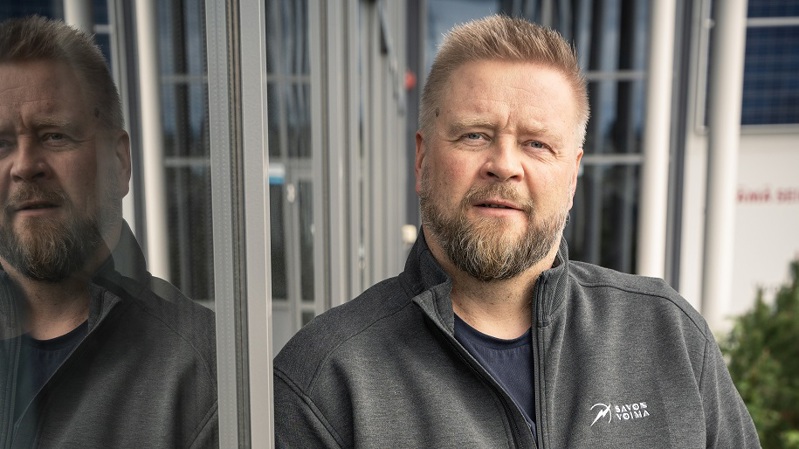Get rid of type 2 diabetes with lifestyle changes
When Timo Partanen found out at his health check that he had type 2 diabetes, he realised that he would end up taking medication for the rest of his life if things continued as they were. The diagnosis made him think about his future and motivated him to make a permanent change.

Partanen has more than 30 years of experience in the energy sector. The job of a technical manager is very familiar to many office workers; work is mainly done on a terminal and physical activity during the working day is very moderate. This was also the case for Mr Partanen, and as his working years had increased, his leisure time physical activities had become less frequent, despite a strong sporting background in his youth.
– My job is independent and requires not only managing my own work but also my own well-being at work. I admit that in the past I did not pay so much attention to issues such as nutrition and activity during the working day, even though I was aware of the risks that inactivity and a slowly increasing weight had brought with it.
The fluctuating energy levels during the working day had not yet worried Mr Partanen enough, but at his health check it was discovered that his sugar levels had risen rapidly to alarming levels. He was referred to a diabetes nurse to start treatment for the flare-up. Like so many others, Partanen only woke up after his diagnosis.
– My habit has always been to look into things thoroughly. Even type two diabetes, if left untreated, can lead to limb loss, blindness and dialysis; all futures I do not wish for myself. Fortunately, my own scores were not yet at such a critical point, although drug treatment was started immediately. I realised that by changing my own lifestyle, I could also get off the drugs and have a healthier and more prosperous life in their place.
Professional support on the journey of change
Partanen sought help with her everyday changes from nutritionist Päivi Lassila, who helped her to overhaul her diet. She eliminated fast carbohydrates from her diet and focused on slow carbohydrates, while increasing the proportion of vegetables and protein. Meal rhythms also became regular during telecommuting days, which helped to control blood sugar levels. In addition, Partanen returned to exercise, which contributed to his overall well-being and energy levels.
– What worked for me was that I made quite radical changes at one time. The effects were small at first, but over time they built up and I noticed significant improvements in my energy levels and general health. I also monitored the effect of the changes I made on my blood pressure and after six months it was so good that I was able to stop taking the medication. As my blood sugar levels levelled off, my mood and energy levels improved significantly. This was reflected in my own ability to work, and has also grown me as a chaperone. As someone who has experienced change myself, I share my own change openly in the hope that it will help someone else. I encourage everyone to take care of their work-life balance. I know from practical experience the impact that well-being has on your ability to cope and perform.
Prevention and early response to change pays off
At work, Partanen looks after the maintenance of energy production equipment and says he has continued to monitor the development of his own values in a similar way in the Terveystalo application.
– In maintenance, the alarm bells start ringing as soon as the vibrations in the bearing start to rise. Proactive action is needed, otherwise the rise will continue, leading inevitably to equipment failure. One's own health also requires constant monitoring and care, and no one should expect to end up with a diagnosis because of their lifestyle. Although type 2 diabetes has been overcome at this point in my journey of change, I know that by returning to my old lifestyle, diabetes could well return to my life. It's smart to react to the evolution of your own values at the point where they predict the onset of the disease.
Timo Partanen's tips for lifestyle change
- Change always requires personal motivation and commitment. It is up to each individual to take the steps towards a healthier lifestyle, but it is worthwhile to enlist the help of a professional on the journey of change.
- Set a goal for lasting change and, if necessary, take small steps, bit by bit.
- Pay attention to your diet and meal rhythm: avoid fast carbohydrates, increase vegetables and protein, and keep your meal rhythm regular to keep blood sugar levels steady.
- Add some physical activity to your daily routine - even a little daily exercise can do wonders.
- Keep yourself motivated by tracking your progress regularly. Remember that change takes time and patience, but the results are worth it.
Lue lisää aiheesta

Terveystalo's digital services have been awarded the internationally recognized ISO27001 information security certification.
Terveystalo's information security practices, processes, and risk management are in line with international best practices.

Does massage help relieve stress? – Touch restores and calms the body and mind
Stress is not always visible on the outside, but the body does show signs when the strain increases. According to Lassi Ylönen, a trained massage therapist at Terveystalo Rela, the body often communicates stress through subtle signs.

Circular economy and artificial intelligence boost performance and improve care
At the heart of sustainable healthcare, technology serves as a tool for improving both the quality of care and accountability. Terveystalo favors solutions that combine sustainability, cost-effectiveness, and medical expertise.

Psychologist: How to make Christmas a relaxed and personal celebration
For many, the anticipation of Christmas begins when cities are decked out in seasonal lights and the first chocolates, calendars, and gingerbread cookies appear on store shelves. Christmas carols ring out and the Tonttuparaati choir sings “Kiire jo on! Kiire jo on!” (Hurry up! Hurry up!). This warm and atmospheric celebration also brings other feelings to mind: how on earth can we get through all this without losing our joy and peace in the rush?

Terveystalo and Gosta Labs deepen their cooperation: the goal is to streamline work with a superior patient information system
Terveystalo is deepening its cooperation with Finnish health technology company Gosta Labs and investing €1 million in the company as a minority investor. The aim is to jointly develop artificial intelligence solutions that improve the quality of care and the efficiency of reception work as part of Terveystalo's new patient information system, Terveystalo Ella.

First aid preparedness in companies requires action and courage
First aid skills increase resilience, but a barometer survey of Finnish organizations' first aid capabilities published in October reveals that the number of trained personnel is alarmingly low.